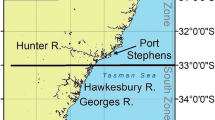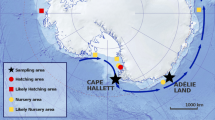Abstract
Chum salmon (Oncorhynchus keta) in the North Pacific Ocean are anadromous fish, and spend most of their life in the sea until spawning in natal streams. To identify the stock and habitat characteristics of chum salmon, the composition of chemical elements (Ca, Mn, Sr, Zn, and Ba) in otolith was examined using laser ablation inductively coupled plasma mass spectrometry (LA-ICPMS). Two main types of analytical work have been carried out; discrete spot analysis and line scan analysis of otolith sections. Salmon otoliths were obtained from the eastern (Canada and USA) and western (Japan and Korea) North Pacific during 1997–1999 spawning seasons. Spot analysis of otolith cores demonstrated significant differences in the element concentration among countries (p = 0.003). Line scanning from the core to the margin showed that Sr concentrations were elevated at the core of the otoliths, decreased during the freshwater stage, increased suddenly at a certain point, and oscillated periodically towards the margin matching with year-ring. The elevated Sr concentration at the core may reflect the maternal contribution to the egg, and the oscillations toward the margin may reflect salinity gradients between onshore/offshore or north/south migrations. The Zn profiles also oscillated and corresponded to the annual ring of the otolith. However, the profiles of Sr and Zn oscillated oppositely after salmon migrated to saline water and the Zn uptake declined toward the rim of the otolith while Sr uptake increased.
Similar content being viewed by others
References
Arai N, Sakamoto W, Maeda K (1996) Correlation between ambient seawater temperature and strontium-calcium concentration ratios in otoliths of red sea bream Pagrus major. Fish Sci 62:652–653
Babaluk JA, Halden NM, Reist JD, Kristofferson AH, Campbell JL, Teesdale WJ (1997) Evidence for non-anadromous behaviour of Arctic charr (Salvelinus alpinus) from Lake Hazen, Ellesmere Island, Northwest Territories, Canada, based on scanning proton microprobe analysis of otolith strontium distribution. Arctic 50:224–233
Bath GE, Thorrold SR, Jones CM, Campana SE, McLaren JW, Lam JWH (2000) Strontium and barium uptake in aragonitic otoliths of marine fish. Geochim Cosmochim Acta 64:1705–1714
Beacham TD, Candy JR, Supernault KJ, Wetklo M, Deagle B, Labaree K, Irvine JR, Miller KM, Nelson RJ, Withler R (2003) Evaluation and application of microsatellite and major histocompatability complex variation for stock identification of coho salmon in British Columbia. Trans Am Fish Soc 130:1116–1155
Bigler BS, Welch DW, Helle JH (1996) A review of size trends among North Pacific salmon (Oncorhynchus spp.). Can J Fish Aquat Sci 53:455–465
Bradbury IR, Campana SE, Bentzen P (2008) Estimating contemporary early life-history dispersal in an estuarine fish: Integrating molecular and otolith elemental approaches. Mol Ecol 17:1438–1450
Brenkman SJ, Corbett SC, Volk EC (2007) Use of otolith chemistry and radiotelemetry to determine age-specific migratory patterns of anadromous bull trout in the Hoh River, Washington. Trans Am Fish Soc 136(1):1–11
Brown R, Severin KP (1999) Elemental distribution within polymorphic inconnu (Stenodus leucichthys) otoliths is affected by crystal structure. Can J Fish Aquat Sci 56:1898–1903
Campana SE (1999) Chemistry and composition of fish otoliths: pathways, mechanisms and applications. Mar Ecol-Prog Ser 188:263–297
Campana SE, Fowler AJ, Jones CM (1994) Otolith elemental fingerprinting for stock identification of Atlantic cod (Gadus morhua) using laser ablation ICPMS. Can J Fish Aquat Sci 51:1942–1949
Campana SE, Chouinard GA, Hanson JM, Fréchet A (1999) Mixing and migration of overwintering cod stocks near the mouth of the Gulf of St. Lawrence. Can J Fish Aquat Sci 56:1873–1881
Campbell JL, Babaluk JA, Halden NM, Kristofferson AH, Maxwell JA, Mejia SR, Reist JD, Teesdale WJ (1999) Micro-PIXE studies of char populations in northern Canada. Nucl Instrum Meth B 150:260–266
Elsdon TS, Gillanders BM (2003a) Reconstructing migratory patterns of fish based on environmental influences on otolith chemistry. Rev Fish Biol Fisher 13:219–235
Elsdon TS, Gillanders BM (2003b) Relationship between water and otolith elemental concentrations in juvenile black bream Acanthopagrus butcheri. Mar Ecol-Prog Ser 260:263–272
Farrell J, Campana SE (1996) Regulation of calcium and strontium, deposition on the otoliths of juvenile Tilapia, Oreochromis niloticus. Comp Biochem Physiol A 15:103–109
Gunn JS, Harrowfield IR, Proctor CH, Thresher RE (1992) Electron microanalysis of fish otoliths — evaluation of techniques for studying age and stock discrimination. J Exp Mar Biol Ecol 158:1–36
Halden NM, Friedrich LA (2008) Trace-element distributions in fish otoliths: Natural markers of life histories, environmental conditions and exposure to tailings effluence. Mineral Mag 72:593–605
Irvine JR, Fukuwaka M (2011) Pacific salmon abundance trends and climate change. ICES J Mar Sci 68:1122–1130
Jenner GA, Longerich HP, Jackson SE, Fryer BJ (1990) ICP-MS — A powerful tool for high precision trace element analysis in Earth sciences: Evidence from analysis of selected U.S.G.S. reference samples. Chem Geol 83:133–148
Kaeriyama M, Seo H, Kudo H, Nagata M (2012) Perspectives on wild and hatchery salmon interactions at sea, potential climate effects on Japanese chum salmon, and the need for sustainable salmon fishery management reform in Japan. Environ Biol Fish 94:165–177
Kalish JM (1991) Determinants of otolith chemistry: seasonal variations in the composition of blood plasma, endolymph and otoliths of bearded rock cod Pseudophycis barbatus. Mar Ecol-Prog Ser 74:137–159
Kang S, Kim S (2004) Comparison of biological characteristics of chum salmon, Oncorhynchus keta from the eastern and western North Pacific. J Korean Soc Fish Res 6:153–162
Kim GE, Lee YH, Kang G, Kim C, Jung W, Seong KB, Seeb JE, Kim S, Kang S (2007) Genetic diversity and population structure of chum salmon in the North Pacific. North Pacific Anadromous Fish Comm Bull 4:203–209
Lacroix GL, McCurdy P (1996) Migratory behavior of post-smolt Atlantic salmon during initial stages of seaward migration. J Fish Biol 49:1086–1101
Limburg KE (1995) Otolith strontium traces environmental history of subyearling American shad Alosa sapidissima. Mar Ecol-Prog Ser 119:25–35
Longerich HP, Jackson SE, Günther D (1996) Inter-laboratory note. Laser ablation inductively coupled plasma mass spectrometric transient signal data acquisition and analyte concentration calculation. J Anal Atom Spectrom 11:899–904
Mank AJG, Mason PRD (1999) A critical assessment of laser ablation ICP-MS as an analytical tool for depth analysis in silicabased glass samples. J Anal Atom Spectrom 14:1143–1153
McFarlane GA, Zhang CI, King JR, Kim S, Beamish RJ, Oh JH (2009) Contrast in Life Histories of Exploited Fishes and Ecosystem Structures in Coastal Waters off West Canada and East Korea. Ocean Sci J 44:43–60
Pickhardt C, Becker JS, Dietze H-J (2000) A new strategy of solution calibration in laser ablation inductively coupled plasma mass spectrometry for multielement trace analysis of geological samples. Fresenius J Anal Chem 368:173–181
Rodushkin MD, Axelsson D, Malinovsky D, Baxter DC (2002) Analyte- and matrix-dependent elemental response variations in laser ablation inductively coupled plasma mass spectrometry. Part 1. The roles of plasma and ion sampling conditions. J Anal Atom Spectrom 17:1223–1230
Ruggerone GT, Agler BA, Nielsen JL (2012) Evidence for competition at sea between Norton Sound chum salmon and Asian hatchery chum salmon. Environ Biol Fish 94:149–163
Salo EO (1991) Life history of chum salmon (Oncorhynchus keta). In: Groot C, Margolis L (eds) Pacific Salmon life histories. UBC Press, pp 233–309
Sanborn M, Telmer K (2003) The spatial resolution of LA-ICPMS line scans across heterogeneous materials such as fish otoliths and zoned minerals. J Anal Atom Spectrom 18:1231–1237
Secor DH (1992) Application of otolith microchemistry analysis to investigate anadromy in Chesapeake Bay striped bass Morones axatilis. Fish Bull 90:798–806
Secor DH, Henderson-Arzapalo A, Piccoli PM (1995) Can otolith microchemistry chart patterns of migration and habitat utilization in anadromous fishes? J Exp Mar Biol Ecol 192:15–33
Sohn D, Kang S, Kim S (2005) Stock identification of chum salmon (Oncorhynchus keta) using trace elements in otolith. J Oceanogr 61:305–312
Thorrold SR, Jones CM, Campana SE, McLaren JW, Lam JWH (1998a) Trace element signatures in otoliths record natal river of juvenile American shad (Alosa sapidissima). Limnol Oceanogr 43:1826–1835
Thorrold SR, Jones CM, Swart PK, Targett TE (1998b) Accurate classification of juvenile weakfish Cynoscion regalis to estuarine nursery areas based on chemical signatures in otoliths. Mar Ecol-Prog Ser 173:253–265
Trudel M, Fisher J, Orsi JA, Morris JFT, Thiess ME, Sweeting RM, Hinton S, Fergusson EA, Welch DW (2009) Distribution and migration of juvenile Chinook salmon derived from coded wire tag recoveries along the continental shelf of western North America. Trans Am Fish Soc 138:1369–1391
Tzeng WN, Severin KP, Wickström H (1997) Use of otolith microchemistry to investigate the environmental history of European eel Anguilla anguilla. Mar Ecol-Prog Ser 149:73–81
Tzeng WN, Severin KP, Wickström H, Wang C-H (1999) Strontium bands in relation to age marks in otoliths of European eel Anguilla anguilla. Zool Stud 38:452–457
Tzeng WN, Tsai YC (1994) Changes in otolith microchemistry of the Japanese eel, Anguilla japonica, during its migration from the ocean to the rivers of Taiwan. J Fish Biol 45:671–683
Urawa S, Ueno Y, Ishida Y, Seeb LW, Crane PA, Abe S, Davis ND (2001) A migration model of Japanese chum salmon during early ocean life. North Pacific Anadromous Fish Comm Tech Rep 2:1–2
Wang S, Brown R, Gray DJ (1994) Application of laser ablation-ICPMS to the spatially resolved micro-analysis of biological tissue. Appl Spectrom 48:1321–1325
Author information
Authors and Affiliations
Corresponding author
Rights and permissions
About this article
Cite this article
Kang, S., Kim, S., Telmer, K. et al. Stock identification and life history interpretation using trace element signatures in salmon otoliths. Ocean Sci. J. 49, 201–210 (2014). https://doi.org/10.1007/s12601-014-0020-y
Received:
Revised:
Accepted:
Published:
Issue Date:
DOI: https://doi.org/10.1007/s12601-014-0020-y




